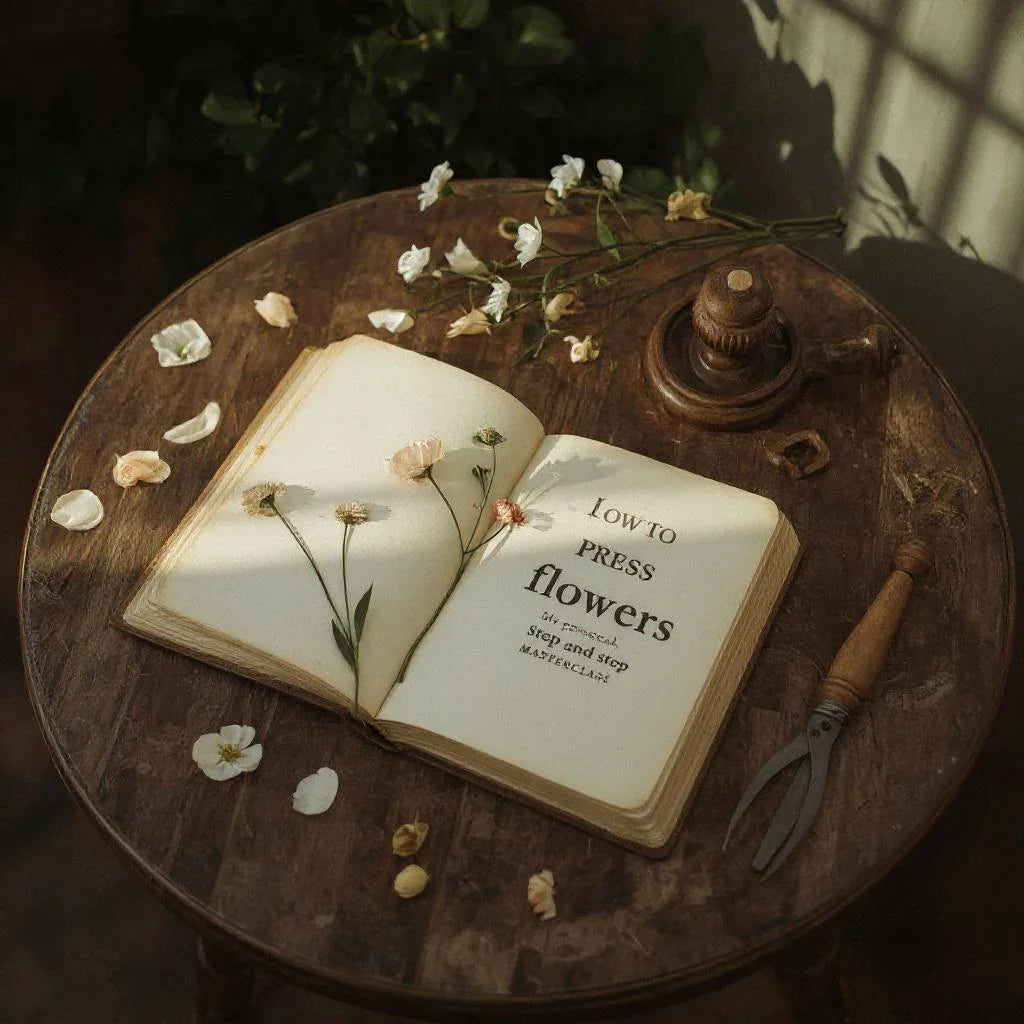
How to Press Flowers: My Personal, Step-by-Step Masterclass
Preserving the beauty of a single bloom first taught me that time can stand still. In this expanded guide—packed with every detail, pro tip, and troubleshooting trick—you’ll learn how to press flowers like a seasoned botanist and craft stunning keepsakes that last a lifetime.
Introduction: A Bloom from Grandma’s Garden
The first flower I ever pressed was a pink peony from my grandmother’s garden. I tucked it into her old cookbook and forgot about it for two weeks. When I finally opened the pages, that delicate blossom still held its vibrant color. That moment hooked me for life. Now, I’m sharing every method I’ve perfected—from classic book-pressing to high-tech dehydrator tricks—so you can capture your own floral memories.
Why Press Flowers?
Pressing flowers transforms fleeting blooms into treasures you can hold forever. It allows you to save wedding bouquets or prom corsages for anniversaries, create framed botanical prints, handcrafted greeting cards, and bookmarks, and upcycle spent centerpieces into sustainable home accents. Gather a handful of freshly cut petals and let’s dive in!
The Science Behind Perfect Pressing
Understanding why pressing works helps ensure flawless results. Slow, consistent drying removes moisture and prevents mold growth. Even pressure collapses plant cells and locks in vibrant pigments, so reds, purples, and yellows stay true. Choosing acid-free parchment or coffee filters protects petals from yellowing over time.
My Essential Toolkit
Before you begin, assemble these must-have items: fresh, flat-faced blooms such as pansies, violets, and daisies for quick, even pressing; parchment paper or coffee filters; a flower press or heavy hardcover books; 20–30 pounds of weight (textbooks or bricks work well); tweezers for delicate handling; silica gel packets if you want three-dimensional drying; and a glycerin-and-water solution (one part glycerin to two parts water) for soft preservation. Harvest blooms mid-morning, after the dew evaporates but before the sun wilts the petals.
How to Press Flowers: Step-by-Step
1. Select and Sort Your Blooms
Choose blossoms at peak color and discard any with blemishes or insect damage. Group thin petals like violets separately from thick petals such as roses to ensure even drying.
2. Prepare the Pressing Surface
Lay one sheet of parchment on the press platen or open book page. Arrange flowers face-down with petal tips pointing inward to avoid curling, then cover with a second parchment sheet.
3. Apply Even Pressure
Tighten the press screws or close the book firmly. Distribute 20–30 pounds of weight evenly across the surface by stacking books or bricks on top.
4. Wait the Right Amount of Time
Leave the flowers undisturbed for seven to ten days. At day five, gently lift one corner of the parchment; if it feels damp, swap it for a dry sheet.
5. Reveal and Store Your Treasures
Use tweezers to lift petals gently from the edges inward. Store your pressed blooms flat in airtight, UV-protected boxes, or seal them between glass for display frames.
Try your first press today and share your results in the comments!
Pressing in a Book: DIY Method
If you don’t have a flower press, a sturdy hardcover book works just as well. Open the book to its center spread and position your parchment–flower–parchment layers inside. Close the book and stack additional volumes on top for uniform weight. Leave the arrangement undisturbed for seven to ten days, then carefully remove your perfectly pressed blooms.
Beyond Pressing: Drying Methods for 3D Blooms
Air Drying
Tie small bunches of flowers with twine and hang them upside down in a dark, well-ventilated area for two to three weeks. Check weekly; the stems should snap cleanly when fully dry.
Silica Gel Method
Bury your blooms completely in silica gel crystals inside an airtight container. Shake the container gently each day to redistribute the crystals, and finish the process in two to five days to retain vibrant color and natural shape.
Microwave Drying
Place petals between microwave-safe plates lined with silica gel. Heat in 30-second bursts, checking after each interval. The total time typically runs under two minutes—handle with care.
Dehydrator Technique
Spread petals on the trays of a food dehydrator set between 95 °F and 115 °F. Dry for one to three hours, flipping halfway through to ensure even moisture removal.
How to Preserve Wedding Flowers
For heirloom-quality keepsakes, press your wedding bouquet within 24 hours of the ceremony. Submerge the stems in a glycerin-and-water mix (one part glycerin to two parts water) for two weeks. To add a glossy shell, dip your pressed petals in melted paraffin wax and let them cool to harden. For jewelry or paperweights, arrange the petals in silicone molds, pour clear epoxy resin, and allow it to cure. My sister’s bouquet, preserved this way, still looks fresh five years later, framed in glass.
Creative Crafts with Pressed & Dried Flowers
You can turn pressed petals into a variety of crafts: cut petal templates from cardstock and layer them around wire stems to create realistic paper flowers, or stack tissue paper sheets, accordion-fold them, tie the center, and fluff the layers for vibrant blooms. Fold square origami paper into lilies or tulips without any glue. Use fine yarn to crochet delicate flowers, and twist pipe cleaners into loops for whimsical, sturdy petals. For collage art, arrange pressed petals on canvas and seal with archival glue. Trace petals on fabric to embroider with satin and stem stitches, and sketch basic shapes like circles and ovals before applying watercolor washes and layered shading for painted floral art.
How to Wrap Flowers in Paper
Lay a sheet of kraft or patterned paper diagonally on your workspace, then place the stems slightly off-center. Fold two opposite corners up over the blooms, followed by the remaining corners, and secure everything with twine or ribbon. Tucking in a sprig of eucalyptus adds both fragrance and texture.
Troubleshooting & Storage Tips
If petals curl at the edges, add more weight or extend the drying time by two to three days. Should you spot mold, replace any damp paper immediately and improve airflow around your press. If colors fade, enhance them with a light coat of clear resin or a gentle glycerin soak. For long-term storage, keep pressed and dried flowers in airtight, UV-protected boxes or sealed frames, and include silica packets to absorb any stray moisture.
Conclusion: Your Next Bloom Awaits
From that first peony pressed in my grandmother’s cookbook to gallery-worthy frames today, pressing flowers has been a rewarding journey of creativity and discovery. Armed with these detailed methods, pro tips, and troubleshooting tricks, you’re ready to capture—and craft—the floral beauty all around you. Take the next step by visiting Black Petals for premium blooms, DIY kits, and expert support. Let’s preserve nature’s artistry together
Frequently Asked Questions About Pressing Flowers
1. How long do pressed flowers actually last?
When stored properly in airtight, UV-protected frames or archival boxes, pressed flowers can last for decades without losing their shape. Colors may soften over time, but using acid-free paper and silica gel helps preserve vibrancy. Some well-kept pressed flowers have lasted over 50 years.
2. What flowers press the best for beginners?
Flat, thin-petaled flowers such as pansies, daisies, violets, and ferns are easiest for first-time pressers. Thick blooms like roses or lilies can also be pressed, but they take longer and require more pressure or partial petal trimming for best results.
3. Can I press flowers without parchment paper?
Yes, but parchment or blotting paper is ideal because it absorbs moisture evenly and prevents mold. If you don’t have parchment, try coffee filters, plain printer paper, or paper towels. Avoid glossy or coated paper, as it traps moisture and damages petals.
4. Do pressed flowers lose their color?
Most flowers retain their natural pigments for years if dried correctly. Bright yellows, purples, and blues tend to hold color longer, while reds may darken slightly. To minimize fading, keep pressed blooms out of direct sunlight and consider sealing them with clear resin.
5. How do I press flowers quickly if I don’t have weeks to wait?
Microwave pressing and silica gel drying are the fastest methods. Microwave pressing can dry blooms in under 2 minutes, while silica gel typically preserves 3D flowers within 2–5 days. These methods are great for last-minute projects like handmade cards or gifts.
6. Can I press my wedding bouquet?
Absolutely. Pressing or drying a wedding bouquet within 24 hours of the ceremony helps preserve its beauty. For heirloom-quality keepsakes, press individual blooms for framing, or use resin casting to preserve whole flowers for jewelry and paperweights.
7. What’s the difference between pressing and drying flowers?
Pressing flattens flowers between weighted surfaces, ideal for crafts like bookmarks and framed art. Drying (air drying, silica gel, or dehydrator) preserves flowers in three dimensions, perfect for bouquets, resin crafts, and home décor arrangements.
8. Can I seal pressed flowers so they don’t break?
Yes—pressed flowers are delicate but can be reinforced. Coat them with a thin layer of clear-drying glue, laminate them, or seal them in resin between glass frames. This not only protects their structure but also enhances color vibrancy.
9. Is pressing flowers eco-friendly?
Yes. Pressing and reusing flowers is a sustainable practice that reduces waste. Instead of discarding bouquets or event arrangements, you can recycle blooms into art, keepsakes, and gifts—making the most of every stem.
10. What are the most creative ways to use pressed flowers?
Pressed flowers can be used in greeting cards, bookmarks, resin jewelry, framed wall art, phone cases, candles, and even wedding invitations. They’re versatile materials that add natural beauty and uniqueness to everyday items.
